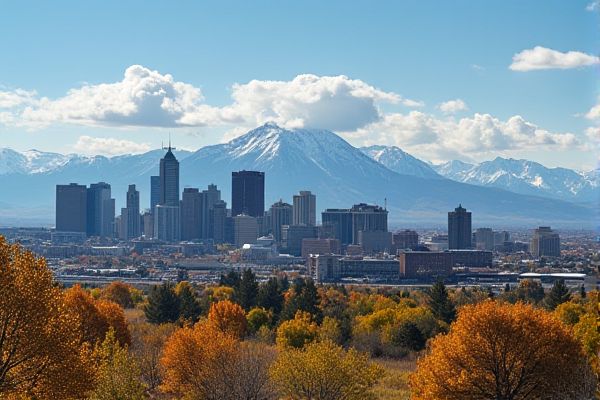
Transportation and commuting in Colorado: Public transit options: buses and light rail. Traffic congestion: prevalent during rush hours. Carpool lanes available on major highways. Denver International Airport: largest airport in the state. Bike-friendly cities with extensive trails. E-470 toll road bypasses Denver traffic. Regional Transportation District (RTD) services. Winter driving: potential snow and icy conditions. Ski shuttles to mountain resorts available. Mountain passes may require 4WD or snow chains.
Public transit options: buses and light rail.
In Colorado, public transit options include extensive bus and light rail networks, particularly through the Regional Transportation District (RTD) in the Denver area, which operates numerous local, regional, and limited bus routes, as well as several light rail and commuter rail lines. Additionally, services like Bustang provide interregional express bus connections along major corridors, and local transit agencies such as Mountain Metro in Colorado Springs offer comprehensive bus services. For more details on navigating these options, you can explore the resources available on the Colorado Official Website.
Traffic congestion: prevalent during rush hours.
In Colorado, particularly in Denver, traffic congestion is no longer limited to traditional rush hours. The post-pandemic era has seen midday travel become as congested as peak times, with the worst congestion occurring between 4-6 pm on weekdays, and the 2 pm hour being as busy as the 6-7 pm timeframe. For more insights into this evolving traffic pattern, visit the detailed coverage on the Axios Denver website.
Carpool lanes available on major highways.
In Colorado, carpool lanes, known as High Occupancy Vehicle (HOV) lanes, are available on several major highways, including I-25, US 36, C-470, and I-70. These lanes are free for vehicles with at least three passengers, motorcycles, or users of priority buses and bus rapid transit, while solo drivers can use them by paying a toll. For more detailed information, you can visit the official website about High Occupancy Vehicle Toll Express Lanes in Colorado.
Denver International Airport: largest airport in the state.
Denver International Airport (DEN) offers a wide range of transportation options, including the A Line train to downtown Denver, RTD buses, taxis, ride-sharing services, charter buses, and car rentals, making it a comprehensive hub for commuting in Colorado. To explore all available options and plan your journey efficiently, visit the Denver International Airport website for detailed information and guidelines.
Bike-friendly cities with extensive trails.
Colorado boasts several bike-friendly cities with extensive trails, such as the Peaks to Plains Trail, Cherry Creek Regional Trail, and Rio Grande Trail, which offer scenic routes through mountains, urban areas, and along rivers, making cities like Denver, Aspen, and Grand Junction popular for cycling. To explore more about these picturesque trails and plan your adventure, visit the Top 10 Trails in Colorado and discover the beauty that awaits cyclists in these vibrant locations.
E-470 toll road bypasses Denver traffic.
E-470 is a 47-mile private toll road that forms an outer beltway around the eastern side of Denver, providing an alternate north-south route to Interstate 25 and helping to bypass heavy traffic in Denver. This route is especially advantageous for travelers accessing Denver International Airport, as it allows them to avoid the congested I-25 and I-70 corridors. For more detailed information on the E-470's impact and features, you can visit the Transportation Planning Tools website.
Regional Transportation District (RTD) services.
The Regional Transportation District (RTD) in Colorado is renowned for its comprehensive public transit system, which encompasses over 100 bus routes and 10 rail lines stretching across 113 miles of track. This includes specialty services such as the A Line to Denver International Airport and various light rail and commuter rail options. RTD serves a vast 2,342-square-mile area, ensuring reliable and accessible transportation for approximately 3.08 million individuals across eight counties within the Denver-Aurora combined statistical area. For more information, you can visit the Regional Transportation District site to explore its offerings and updates.
Winter driving: potential snow and icy conditions.
To navigate winter driving in Colorado, it is essential to ensure good tire tread, start and stop gradually to maintain traction, drive at steady speeds, and avoid braking on curves. Additionally, preparing an emergency kit and checking vehicle conditions are crucial. By following safety tips from Drive Smart Colorado, such as using low-beam headlights and leaving extra space between vehicles, you can ensure a safer driving experience during the colder months.
Ski shuttles to mountain resorts available.
The majestic Colorado mountains are made accessible by a variety of ski shuttle services, catering to different destinations and preferences. Those looking to reach prestigious ski resorts like Monarch Mountain, Breckenridge, Keystone, and Arapahoe Basin from Colorado Springs can rely on Rocky Mountain Ride for their punctual shared ski shuttles, which conveniently depart early in the morning and offer the ease of free ski gear transport and enticing group discounts. For those traveling from Denver, Summit Express provides daily scheduled airport shuttles, ensuring seamless connections to Summit County’s popular spots, including Breckenridge, Keystone, and Copper Mountain. Travelers also have the option to explore routes offered by The Snowstang Bus Service, which facilitates roundtrip journeys to ski havens such as Loveland Ski Area, Copper Mountain, Arapahoe Basin, and Steamboat Resort, while the Bustang service extends further, linking numerous mountain towns and celebrated ski areas like Monarch Mountain, Purgatory Resort, and Telluride Ski Resort.
Mountain passes may require 4WD or snow chains.
In Colorado, mountain passes often mandate the use of 4WD or snow chains, particularly during the period from September 1 to May 31. This requirement is in place to ensure safety and compliance with specific regulations concerning tire tread depth and the implementation of chains or alternative traction devices. These regulations are dictated by the vehicle's weight and prevailing weather conditions. For more detailed information on these regulations, visit the Colorado Chain Law guide provided by the Colorado Department of Transportation.
